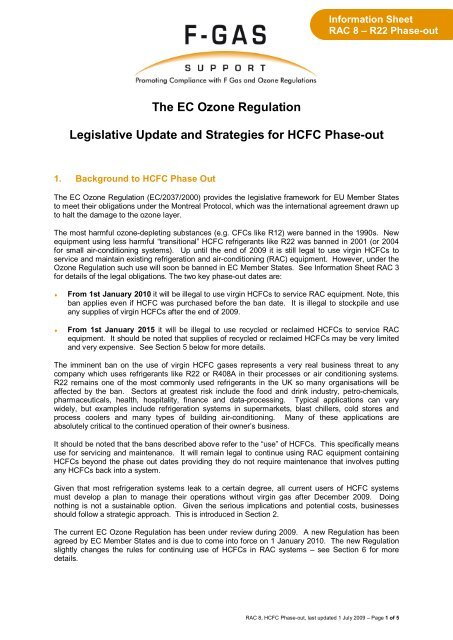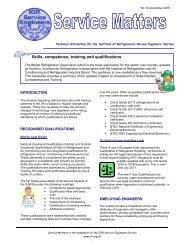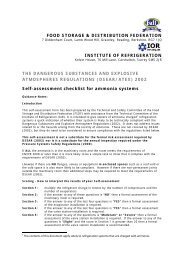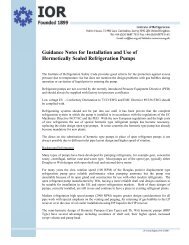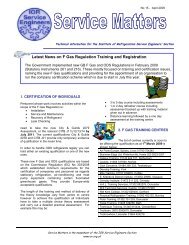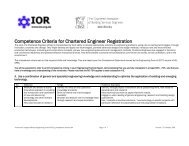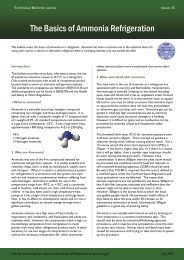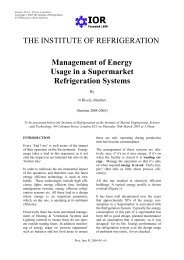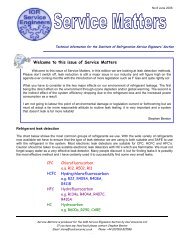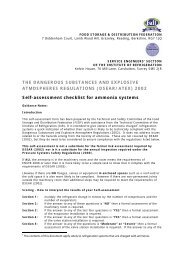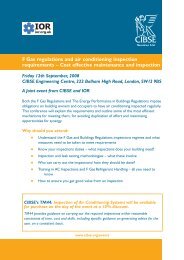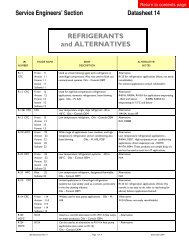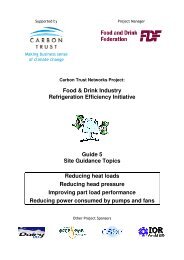R22 Phase Out and F Gas Regulations
R22 Phase Out and F Gas Regulations
R22 Phase Out and F Gas Regulations
You also want an ePaper? Increase the reach of your titles
YUMPU automatically turns print PDFs into web optimized ePapers that Google loves.
Information Sheet<br />
RAC 8 – <strong>R22</strong> <strong>Phase</strong>-out<br />
The EC Ozone Regulation<br />
Legislative Update <strong>and</strong> Strategies for HCFC <strong>Phase</strong>-out<br />
1. Background to HCFC <strong>Phase</strong> <strong>Out</strong><br />
The EC Ozone Regulation (EC/2037/2000) provides the legislative framework for EU Member States<br />
to meet their obligations under the Montreal Protocol, which was the international agreement drawn up<br />
to halt the damage to the ozone layer.<br />
The most harmful ozone-depleting substances (e.g. CFCs like R12) were banned in the 1990s. New<br />
equipment using less harmful “transitional” HCFC refrigerants like <strong>R22</strong> was banned in 2001 (or 2004<br />
for small air-conditioning systems). Up until the end of 2009 it is still legal to use virgin HCFCs to<br />
service <strong>and</strong> maintain existing refrigeration <strong>and</strong> air-conditioning (RAC) equipment. However, under the<br />
Ozone Regulation such use will soon be banned in EC Member States. See Information Sheet RAC 3<br />
for details of the legal obligations. The two key phase-out dates are:<br />
<br />
<br />
From 1st January 2010 it will be illegal to use virgin HCFCs to service RAC equipment. Note, this<br />
ban applies even if HCFC was purchased before the ban date. It is illegal to stockpile <strong>and</strong> use<br />
any supplies of virgin HCFCs after the end of 2009.<br />
From 1st January 2015 it will be illegal to use recycled or reclaimed HCFCs to service RAC<br />
equipment. It should be noted that supplies of recycled or reclaimed HCFCs may be very limited<br />
<strong>and</strong> very expensive. See Section 5 below for more details.<br />
The imminent ban on the use of virgin HCFC gases represents a very real business threat to any<br />
company which uses refrigerants like <strong>R22</strong> or R408A in their processes or air conditioning systems.<br />
<strong>R22</strong> remains one of the most commonly used refrigerants in the UK so many organisations will be<br />
affected by the ban. Sectors at greatest risk include the food <strong>and</strong> drink industry, petro-chemicals,<br />
pharmaceuticals, health, hospitality, finance <strong>and</strong> data-processing. Typical applications can vary<br />
widely, but examples include refrigeration systems in supermarkets, blast chillers, cold stores <strong>and</strong><br />
process coolers <strong>and</strong> many types of building air-conditioning. Many of these applications are<br />
absolutely critical to the continued operation of their owner’s business.<br />
It should be noted that the bans described above refer to the “use” of HCFCs. This specifically means<br />
use for servicing <strong>and</strong> maintenance. It will remain legal to continue using RAC equipment containing<br />
HCFCs beyond the phase out dates providing they do not require maintenance that involves putting<br />
any HCFCs back into a system.<br />
Given that most refrigeration systems leak to a certain degree, all current users of HCFC systems<br />
must develop a plan to manage their operations without virgin gas after December 2009. Doing<br />
nothing is not a sustainable option. Given the serious implications <strong>and</strong> potential costs, businesses<br />
should follow a strategic approach. This is introduced in Section 2.<br />
The current EC Ozone Regulation has been under review during 2009. A new Regulation has been<br />
agreed by EC Member States <strong>and</strong> is due to come into force on 1 January 2010. The new Regulation<br />
slightly changes the rules for continuing use of HCFCs in RAC systems – see Section 6 for more<br />
details.<br />
RAC 8, HCFC <strong>Phase</strong>-out, last updated 1 July 2009 – Page 1 of 5
2. HCFC <strong>Phase</strong>-<strong>Out</strong> Strategy<br />
The six point plan below provides a model for a successful phase-out strategy:<br />
Assess the Risk – Identify all systems containing HCFCs <strong>and</strong> estimate their associated business risk.<br />
Prioritise – identify the most business-critical systems <strong>and</strong> address these first. But do not neglect all<br />
the other systems, these must also be managed.<br />
Determine the <strong>Phase</strong>-out Solution – on a plant-by-plant basis, identify the most appropriate phase<br />
out solution. These are likely to fall within one of three main options: Replace, Convert or Leave As-Is.<br />
These are described in more detail in Section 3. Each plant must be assessed against a number of<br />
decision criteria to identify the optimum solution. These include system type, age, condition,<br />
availability <strong>and</strong> energy efficiency (see Section 4 for details).<br />
Planning <strong>and</strong> Budgeting – develop a <strong>Phase</strong>-out Plan, with phased implementation of the <strong>Phase</strong>-out<br />
Solutions. Depending on the size of your operation, it is unlikely to be possible or desirable to carry<br />
out all the actions at once. This will need to be done in association with your refrigeration contractor,<br />
in order to ensure their own commitment.<br />
Implementation – carry out the plan, with monitoring <strong>and</strong> regular review.<br />
Managed Use of Recycled HCFCs – due to the short period of time before the end of 2009, it is likely<br />
that many HCFC systems will still be in operation after the use of virgin HCFC gases is banned. Users<br />
of these systems should manage their own stocks of recycled HCFC gas or secure a supply of<br />
reclaimed HCFC gas (see Section 4). When systems are either replaced or converted, the recovered<br />
gas will be needed to service any systems still using HCFCs. In addition, the continued use of<br />
systems containing HCFCs will be subject to regulations similar to those of the EC F gas Regulation<br />
(regular leak testing, prompt repair by qualified personnel <strong>and</strong> record-keeping) – see Section 6.<br />
3. <strong>Phase</strong>-out Solutions<br />
After identifying all systems using HCFC refrigerants, each one should be assessed against decision<br />
criteria <strong>and</strong> assigned one of three main <strong>Phase</strong>-out Solutions. These are:<br />
3.1. Replace<br />
Some old systems, including those that are in poor condition, inefficient or not meeting their current (or<br />
forecast) cooling load, should be replaced with new systems using a non-ODS refrigerant. These can<br />
include HFCs (but these must comply with the EC F gas <strong>Regulations</strong>) or a “natural” refrigerant like<br />
hydrocarbons, ammonia or carbon dioxide.<br />
This option can have a number of important benefits, most importantly the opportunity to significantly<br />
improve energy efficiency. It may also be possible to reduce the charge of refrigerant, either by using<br />
new “critical charge” systems or by employing secondary coolants. Replacement is however likely to<br />
be the most expensive option in up-front cost terms (around 10 times more than a conversion).<br />
3.2. Convert<br />
For many types of RAC system, which are in good order, it will be possible to recommend a Convert<br />
Solution.<br />
This covers a range of actions, from a relatively simple “retrofill” operation (using one of the “service”<br />
or “drop-in” HFC refrigerants that are compatible with the system’s existing mineral oil) to a more<br />
comprehensive modification to a st<strong>and</strong>ard HFC refrigerant (which will require a new type of oil at least,<br />
<strong>and</strong> may require additional compressor <strong>and</strong>/or heat exchanger capacity).<br />
There are a number of “drop-in” gases offered by the main refrigerant suppliers (HFC 417A, HFC<br />
422A, HFC 422D are some of the main ones). They are however all mixtures, with component gases<br />
which boil at slightly different temperatures <strong>and</strong> pressures – a phenomenon known as “glide”. This is<br />
common with many of the other HFC refrigerants (which are widely used in direct expansion systems)<br />
<strong>and</strong> the industry has become familiar with this property. There is not, however, a recognised “retrofill”<br />
solution for flooded or pump-circulation systems. If you have a flooded HCFC system, then you<br />
should approach your refrigeration contactor or an independent consultant as soon as possible.<br />
RAC 8, HCFC <strong>Phase</strong>-out, last updated 1 July 2009 – Page 2 of 5
3.3. Leave As-Is<br />
This is not a “do nothing” option. It is only applicable if:<br />
(a) a guaranteed stock of recycled HCFC is assured; or<br />
(b) the system represents no business-critical risk.<br />
Case (a) may be appropriate if it is not practical to either Replace or Convert the system. This may be<br />
true if, say for a large petro-chemical plant, shut-downs only occur every 2 years <strong>and</strong> the refrigeration<br />
system must be kept running in the meantime. This is however a risky option, since leaks are<br />
unpredictable both in frequency <strong>and</strong> scale.<br />
Case (b) may be appropriate for say small split air-conditioning systems in non-critical offices. These<br />
systems are typically very reliable <strong>and</strong> may continue to operate without trouble for many years. They<br />
can then be replaced relatively quickly <strong>and</strong> cheaply with new systems using a non-ODS refrigerant.<br />
4. Decision Criteria<br />
The decision to either Replace, Convert or Leave an HCFC plant should be based on a number of<br />
criteria. There is no automatic decision algorithm <strong>and</strong> a balanced assessment must be made of each<br />
criterion for each plant. These criteria will include:<br />
System Type – does the system use “direct expansion” or a “flooded” evaporator Direct expansion<br />
(or DX) systems may be suitable for conversion to an HFC replacement gas, but flooded systems<br />
need further consideration. This is an important distinction <strong>and</strong> requires an assessment by an<br />
experienced refrigeration or air conditioning engineer.<br />
Age – refrigeration <strong>and</strong> air-conditioning plant over 20 years old are likely to be approaching the end of<br />
their natural life <strong>and</strong> should probably be replaced. Systems under 10 years should probably be<br />
retrofilled. The bulk of HCFC systems will be between 10 to 20 years old <strong>and</strong> these should be<br />
assessed further. As a further guide, if a system has previously been converted from R12 or R502 to<br />
<strong>R22</strong>, then this should also be replaced <strong>and</strong> not converted a second time.<br />
Condition – if a system has been well maintained <strong>and</strong> is in good condition, this would tend to be more<br />
suitable for a Convert solution. Records of refrigerant leakage are important indicators to the likely<br />
success of a “retrofill” operation.<br />
Meeting Current Requirements – due to the rapid rate of change in many industries, many<br />
refrigeration systems are no longer operating within their original design specification. This is likely to<br />
impinge on operating performance, reliability <strong>and</strong> energy efficiency. The HCFC <strong>Phase</strong> <strong>Out</strong> presents<br />
an opportunity to Replace the system (or alter it) to meet the current <strong>and</strong> forecast application<br />
requirements.<br />
Energy Efficiency – capital costs of commercial <strong>and</strong> industrial refrigeration <strong>and</strong> air-conditioning<br />
systems are typically around 20% of the total lifetime costs. The benefits of replacing an old system<br />
with a new energy-efficient system should be assessed. New options such as free-cooling can be<br />
specified to provide significant on-going savings.<br />
Availability – system-specific characteristics must be considered to identify the correct option. Some<br />
systems are so “embedded” within the factory or building that replacement may be almost impossible.<br />
Alternatively, it may be possible to build a replacement plant alongside the existing HCFC plant <strong>and</strong><br />
then switch-over with the minimum or disruption.<br />
RAC 8, HCFC <strong>Phase</strong>-out, last updated 1 July 2009 – Page 3 of 5
5. Availability <strong>and</strong> Permitted Use of Recycled HCFCs<br />
The availability <strong>and</strong> price of recycled HCFC gases after the end of December 2009 are very uncertain.<br />
There are anecdotal stories of some large industrial companies reserving guaranteed stocks of<br />
reclaimed <strong>R22</strong>, <strong>and</strong> being prepared to pay almost any price.<br />
Any company anticipating using recycled HCFCs to maintain systems after the end of 2009 should<br />
contact their refrigeration supplier to discuss how to meet the anticipated dem<strong>and</strong>. Indeed, due to the<br />
impending deadline on the use of virgin HCFCs, suppliers are likely to run-down their stocks of virgin<br />
gases before the actual deadline, so stocks may become limited before the end of December 2009.<br />
The EC Ozone Regulation has been reviewed <strong>and</strong> the new legislation 1 includes an important<br />
distinction between “recycled” <strong>and</strong> “reclaimed” gases.<br />
Recycled HCFCs – recovered HCFC gas that has been subject only to a basic cleaning process (this<br />
might include mechanical filtering <strong>and</strong> moisture removal). Recycled HCFCs may only be used by<br />
either the undertaking which carried out the recovery (in most cases the refrigeration contractor) or the<br />
undertaking for which the recovery was carried out (the owner). For example, the recycled HCFC<br />
could be taken to another plant that was not owned by the same company, but serviced by the same<br />
contractor or the owner could use the recycled HCFC in RAC equipment at other sites they operate<br />
from.<br />
Reclaimed HCFCs – recovered HCFC gas that has been chemically reprocessed to a specified<br />
st<strong>and</strong>ard. Reclaimed HCFCs may be placed on the wider market <strong>and</strong> used by undertakings other<br />
than the original contractor <strong>and</strong> owner. Reclaimed HCFCs must be held in containers labelled as such,<br />
with information on the batch number <strong>and</strong> name <strong>and</strong> address of the reclamation facility.<br />
Where recycled or reclaimed HCFCs are used, the RAC equipment should be labelled to show:<br />
<br />
<br />
The quantity <strong>and</strong> type of recycled/reclaimed HCFC added in the system, <strong>and</strong><br />
The label elements set out in Annex I to Regulation EC/1272/2008 for substances or mixtures<br />
classified as Hazardous to the Ozone Layer.<br />
Those recovering HCFCs for recycling or reclamation should also consider the following points if<br />
intending to store the materials on site:<br />
<br />
<br />
The holder should ensure that cylinders used to store recovered/recycled HCFCs remain within<br />
their statutory pressure test validation period.<br />
Recovered HCFCs pending recycling or reclamation is hazardous waste. Storage, other than<br />
immediately prior to recycling or transfer for reclamation, requires a formal Environmental<br />
Permitting Licence Exemption from the Environment Agency. This would allow storage of up to 18<br />
tonnes for a maximum period of 6 months. Storage of recycled or reclaimed HCFCs does not<br />
require a permit.<br />
The new legislation also includes the following obligations on undertakings involved in the use of<br />
recycled or reclaimed HCFCs:<br />
<br />
<br />
Users of equipment containing over 3 kg of HCFC refrigerant shall keep a record of the quantity<br />
<strong>and</strong> type of any gases removed or added, <strong>and</strong> of the company or technician carrying out the<br />
service or maintenance.<br />
Undertakings using recycled or reclaimed HCFCs for service or maintenance must keep records<br />
of the undertakings which supplied the reclaimed gases <strong>and</strong> the sources of recycled gases.<br />
Currently there are only a small number of companies in the UK with reclamation facilities. They can<br />
offer a range of solutions to their clients, including the “banking” of reclaimed <strong>R22</strong> in their own storage<br />
facilities.<br />
1 Proposed amendments as published by the Council of the European Union dated 30 March 2009<br />
RAC 8, HCFC <strong>Phase</strong>-out, last updated 1 July 2009 – Page 4 of 5
6. Proposed Amendments to the EC Ozone Regulation<br />
In addition to the points described in Section 5 above, the new legislation includes further obligations<br />
on the operators of HCFC systems. These are broadly similar to the requirements of the EC F gas<br />
Regulation <strong>and</strong> include the following points:<br />
1. Undertakings shall take all precautionary measures practicable to prevent <strong>and</strong> minimise any<br />
leakages <strong>and</strong> emissions of controlled substances.<br />
2. Leak Testing – undertakings operating RAC systems with an HCFC charge of:<br />
<br />
<br />
<br />
3 kg or more are checked for leakage at least once every 12 months; this shall not apply to<br />
equipment with hermetically sealed systems, which are labelled as such <strong>and</strong> contain less<br />
than 6 kg of HCFC;<br />
30 kg or more are checked for leakage at least once every six months;<br />
300 kg or more are checked for leakage at least once every three months;<br />
<strong>and</strong> that any detected leakage is repaired as soon as possible <strong>and</strong> in any event within 14 days.<br />
The equipment or system shall be checked for leakage within one month after a leak has been<br />
repaired to ensure that the repair has been effective.<br />
3. Undertakings referred to in point 2 above shall maintain records on the quantity <strong>and</strong> type of HCFC<br />
added <strong>and</strong> recovered during servicing, maintenance <strong>and</strong> final disposal of the equipment. They<br />
shall also maintain records of other relevant information including the identification of the company<br />
or technician who performed the servicing or maintenance, as well as the dates <strong>and</strong> results of the<br />
leakage checks carried out. These records shall be made available on request to the competent<br />
authority <strong>and</strong> to the Commission.<br />
4. Member States shall define the minimum qualification requirements for the personnel carrying out<br />
activities referred to in paragraph 1.<br />
How to Contact F-<strong>Gas</strong> Support:<br />
Telephone Help Line: 0161 874 3663 Website: www.defra.gov.uk/fgas<br />
Email: fgas-support@enviros.com Post: F-<strong>Gas</strong> Support, P O Box 481, Salford, M50 3UD<br />
This document has been prepared by F-<strong>Gas</strong> Support; the information provided is intended as guidance <strong>and</strong> must not be taken as formal legal advice nor as a definitive statement of the law. Ultimately<br />
only the courts can decide on legal questions <strong>and</strong> matters of legal interpretation. If you have continuing concerns you should seek legal advice from your own lawyers.<br />
F-<strong>Gas</strong> Support is a Government funded team set up to help organisations underst<strong>and</strong> their obligations under the EU Fluorinated Greenhouse <strong>Gas</strong>es <strong>and</strong> Ozone <strong>Regulations</strong>. F-<strong>Gas</strong> Support is also<br />
working with Regulators to promote compliance. It is being run on behalf of Defra <strong>and</strong> the devolved administrations by the Local Authorities Coordinators of Regulatory Services (LACORS) <strong>and</strong> Enviros.<br />
RAC 8, HCFC <strong>Phase</strong>-out, last updated 1 July 2009 – Page 5 of 5


